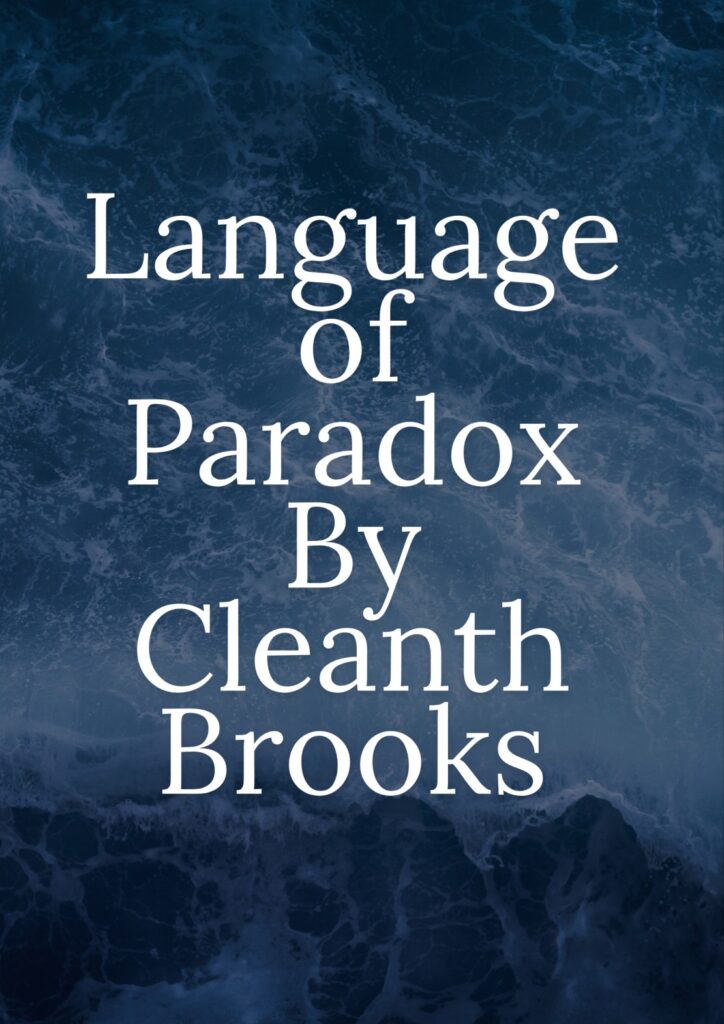Discover the summary of Language of Paradox by Cleanth Brooks. Understand how Brooks redefines poetic language through paradox to reveal deeper truths in literature.
Language of Paradox By Cleanth Brooks

BUY CLEANTH BROOKS FAMOUS BOOK ON AMAZON
Summary of Language of Paradox By Cleanth Brooks
Introduction
“Language of Paradox” is a very important critical essay written by the famous American literary critic Cleanth Brooks. This essay is part of his book “The Well Wrought Urn” (1947), in which he attempts to clarify the nature and uniqueness of English poetry.
Brooks’ main argument in this essay is that the language of poetry is different from common language, and its real power lies in “paradox”. According to Brooks, an effective poem is one that can present contradictory things simultaneously and force readers to think at a deeper level.
Cleanth Brooks and New Criticism
Brooks is considered to be the main promoter of the literary criticism method called New Criticism. The basic objective of New Criticism was that poetry should be evaluated only on the basis of its text (words), and not on the basis of the author’s life, historical context or emotions.
Brooks believed that poetry should be understood through its internal elements such as structure, language, style, and especially “paradox”.
What is Paradox? (What is Paradox in Simple Terms?)
Paradox means – a statement that seems contradictory or impossible at first glance, but on deeper understanding, there is some hidden truth or meaning in it.
Example:
“Whatever you say, even a lie may seem true”
This line seems contradictory on the surface – how can a lie be considered true?
But it reflects the feeling of love in which even the words of the beloved person seem like truth.
Brooks considers this type of paradox as the “natural and necessary language” of poetry.
Main ideas and arguments
✅ 1. Paradox is essential in poetry:
Brooks argues that the soul of poetry is paradox. A good poem does not speak in a straight and flat manner; She creates a complex but beautiful picture by combining emotions, thoughts and experiences, which have meanings at many levels.
And the most effective way to express these meanings is – Paradox.
✅ 2. Ordinary language vs. poetic language:
Brooks explains that in normal life we use language to express facts – such as “It is raining today”.
But poetry rises above these common statements and uses language that is emotional, symbolic and sometimes complicated, so that it can express unsaid and subtle emotions as well.
✅ 3. Paradox brings depth and beauty to poetry:
When a poet uses paradox, he connects the reader not just with words, but with layers of thoughts and emotions.
According to Brooks, paradox is not just a figure of speech, but the medium through which poetry reveals its deep and complex meanings.
Example of poem – The Canonization by John Donne:
Brooks uses John Donne’s poem The Canonization as an example in his essay.
In this poem, two lovers present themselves as saints. This is a paradox in itself, because in society love is often considered worldly and sensual, while saints are considered ascetic and spiritual.
But Donne shows in this poem that love can be as pure as religion or devotion, and in this way he creates a wonderful paradox – the union of worldly love and spiritual advancement.
Brooks takes this as proof that paradox is the most powerful way to reveal layers of meaning within a poem.
Understand from other examples:
1. William Wordsworth – “The child is the father of the man.”
This is a paradox – how can a child be a father?
But this means that childhood experiences shape adulthood.
2. Keats’ poem – “Beauty is truth, truth beauty.”
This is also a paradox because truth and beauty are often considered different.
But in the poem, both are considered the same.
Brooks’ Conclusion
Brooks’ conclusion is that poetry cannot be understood only by clear and logical language. It contains things that are beyond logic – and paradox is necessary to express those things.
If you remove paradox from poetry, it will become just a simple moral sermon or statement. But paradox gives it depth, emotional complexity and intellectual intensity.
Conclusion
“Language of Paradox” is a revolutionary essay, which makes it clear that the way to understand and evaluate poetry should be different from the criteria of common language. According to Cleanth Brooks, paradox is an essential part of poetry because poetry reveals the very complexities of life that appear paradoxical on the surface.
This essay introduced a new direction in literary criticism, and showed that understanding poetry requires sensitivity and the ability to understand symbols more than logic.
The beauty of poetry lies in its complexity, in its ambiguity, and above all in its paradox. Cleanth Brooks teaches us that the value of poetry lies in its depth and multilayeredness – and this depth emerges through paradox.
Recommended Reading
The Tables Turned By William Wordsworth